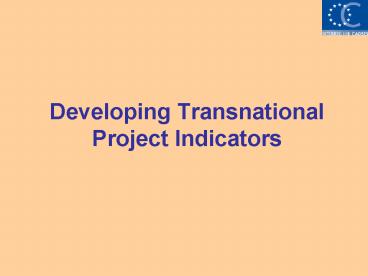Developing Transnational Project Indicators - PowerPoint PPT Presentation
Title: Developing Transnational Project Indicators
1
Developing Transnational Project Indicators
2
The purpose of indicators
gt Indicators are useful tools that allow
programme and project managers to monitor-
Progress- Efficiency- Effectiveness
3
The purpose of indicators 2
- The CADSES programme will use your indicators to
measure your achievements. - The indicators you choose must give an accurate
picture of what you are doing.
4
The purpose of indicators 3
- gt You can also use indicators within the
partnership.Use targets to define delivery
responsibilities and quality requirements. - For example
- Partner 3 is responsible for Development of 3
new technologies to reduce mercury levels in Lake
X by 50 by 2007. - This transparency makes project work much easier.
5
Basic Terminology
- Activities The work done in your project
- Input The resources you use to carry out the
activities - Outputs What your project produces/delivers
- Results The immediate benefits
- Impacts The long-term benefits
6
For example...
- Activity Writing a report
- Input 300 staff hours, 10.000
- Output Report on spatial development in CADSES
area - Result Increased awareness of spatial
development issues in CADSES area - Impact Improved policies based on this new
knowledge
7
Role of Transnational indicators
Output Result Impact
Spatial development perspectives
European integration
Impact
Networking(administration, research, private
sector, countries)
Learning(spatial development, foreign systems)
Result
Documents (analytical, strategic)
Meetings (seminars, workshops, conferences)
Others
Output
8
The limitations of indicators 1
- gt Indicators cannot give a full picture of
- your project they can only provide a
- snapshot of the status of some of the
- work being done.
- gt Therefore, the first decision is to decide
- WHAT to measure what are the interesting and
- important parts of the project?
9
The limitations of indicators 2
- It is often impossible to measure the long-
- term benefit (the impact) of a project within
the lifetime of that project. - Projects must still provide indicators of what
the expected impacts are and how it would be
possible to measure them in future. - Sometimes it may only be possible to state that
the project will make a contribution to achieving
change. This happens when it is impossible to
differentiate the impact of the project from the
impact of other activities.
10
The need for logical connection between indicators
- GOOD (Clear connections)
- Output New filters at water treatment plant -gt
- Result Nitrate levels in water fall by 50 -gt
- Impact Fish stocks in river increase by 25
- BAD (No logical connection)
- Output Analysis of transport systems
- Result Networking between transport workers
- Impact Less pollution from trucks
11
Indicators must also be S.M.A.R.T
- S Specific
- M Measurable
- A Achievable
- R Relevant
- T Timed
12
Specific
- GOOD
- Tourism SMEs in target area have 25 increase in
turnover - BAD
- - Business performance is better
13
Measurable
- GOOD
- - Increase in number areas with access to
broadband internet services. (km2) - Achievable
- GOOD
- 25 crime reduction in pilot project area
- BAD
- - No crime in pilot project area
14
Relevant ... to the projects and programmes
objectives
- Timed
- ... stating when something should happen.
- For example,
- Increase in number of visitors to region by end
of project / by end 2010 / in 2006, etc.
15
Other indicator essentials
- Indicators are quantitative.
- They need a UNIT so we know what is being
measured. - A BASELINE so we know the figure at the start of
the project. - A TARGET so we know the figure that the project
hopes to achieve.
16
For example
UNIT
- Increase in amount of freight (tonnes) carried by
boat on River X by end of 2007. - (Current amount 1.7 million. Estimate by end
2007 2 million)
BASELINE
TARGET
17
Qualitative indicators
- Although indicators should be quantitative, a
qualitative statement will sometimes say more
about the project. - If you use this kind of indicator you still need
to find some way of measuring the qualitative
change.
18
Qualitative indicators 2
- For example
- Improvement in quality of life ( of residents
measured by survey in May 2008) - Like every other project, this one will
- also have to budget for data collection to
- measure performance on this indicator.
19
Conclusions Good indicators must be
- Directly related to the projects most important
objectives. - Logically structured
- SMART (Specific, Measurable, Achievable, Relevant
and Timed) - Provided with a unit, baseline and target
- Necessary data collection should be included in
project budgets
























![General Federation of Nepalese Trade Union [GEFONT] PowerPoint PPT Presentation](https://s3.amazonaws.com/images.powershow.com/7532937.th0.jpg?_=20160113017)






